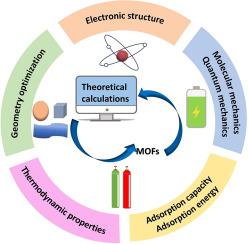Coordination Chemistry Reviews ( IF 20.3 ) Pub Date : 2022-06-22 , DOI: 10.1016/j.ccr.2022.214670 Guangtong Hai , Haihui Wang

|
Metal-organic frameworks (MOFs), a functional material with a large specific surface area and high porosity have attracted increasing attention for their great potential in various applications. As a relatively time-saving, cost-effective, high-efficient and results-predictable method, theoretical calculation has gradually become a trend to guide MOFs material design and development. In this review, the most recent advances in theoretical studies of MOFs were systemically summarized, introducing the development of calculation methods and models with their merits and drawbacks, and emphasizing the employment of theoretical calculations in practical applications of MOFs. First, we briefly introduced the development of MOFs’ database construction, including hypothetical and experimental databases. The calculation methods and models to predict structures and properties of MOFs were thoroughly reviewed in the next part, and the merits and possible limitations are also discussed in detail. Additionally, we summarized the various promising applications of theoretical calculations in catalysis (including electrocatalysis and photocatalysis), selective gas separation and energy storage (including batteries and supercapacitor). The existing challenges of theoretical calculation in MOFs were also pointed out in the outlook. This review will provide a helpful guideline for the rational structure and function design of MOFs, and contribute to the material optimizations in applications of catalysis and energy storage.
中文翻译:

金属有机框架的理论研究:计算方法和在催化、气体分离和储能中的应用
金属有机框架(MOFs)是一种具有大比表面积和高孔隙率的功能材料,因其在各种应用中的巨大潜力而受到越来越多的关注。作为一种相对省时、成本效益高、效率高、结果可预测的方法,理论计算逐渐成为指导MOFs材料设计和开发的趋势。本文系统总结了MOFs理论研究的最新进展,介绍了MOFs计算方法和模型的发展及其优缺点,强调了理论计算在MOFs实际应用中的应用。首先简要介绍了MOFs数据库建设的发展历程,包括假设数据库和实验数据库。下一部分将全面回顾预测 MOF 结构和性能的计算方法和模型,并详细讨论其优点和可能的局限性。此外,我们总结了理论计算在催化(包括电催化和光催化)、选择性气体分离和储能(包括电池和超级电容器)中的各种有前景的应用。展望中还指出了 MOF 理论计算存在的挑战。本综述将为 MOFs 的合理结构和功能设计提供有益的指导,并有助于材料在催化和储能应用中的优化。并详细讨论了优点和可能的局限性。此外,我们总结了理论计算在催化(包括电催化和光催化)、选择性气体分离和储能(包括电池和超级电容器)中的各种有前景的应用。展望中还指出了 MOF 理论计算存在的挑战。本综述将为 MOFs 的合理结构和功能设计提供有益的指导,并有助于材料在催化和储能应用中的优化。并详细讨论了优点和可能的局限性。此外,我们总结了理论计算在催化(包括电催化和光催化)、选择性气体分离和储能(包括电池和超级电容器)中的各种有前景的应用。展望中还指出了 MOF 理论计算存在的挑战。本综述将为 MOFs 的合理结构和功能设计提供有益的指导,并有助于材料在催化和储能应用中的优化。展望中还指出了 MOF 理论计算存在的挑战。本综述将为 MOFs 的合理结构和功能设计提供有益的指导,并有助于材料在催化和储能应用中的优化。展望中还指出了 MOF 理论计算存在的挑战。本综述将为 MOFs 的合理结构和功能设计提供有益的指导,并有助于材料在催化和储能应用中的优化。











































 京公网安备 11010802027423号
京公网安备 11010802027423号